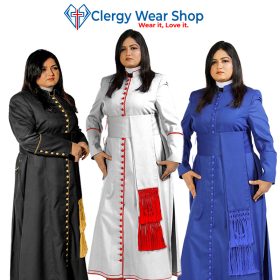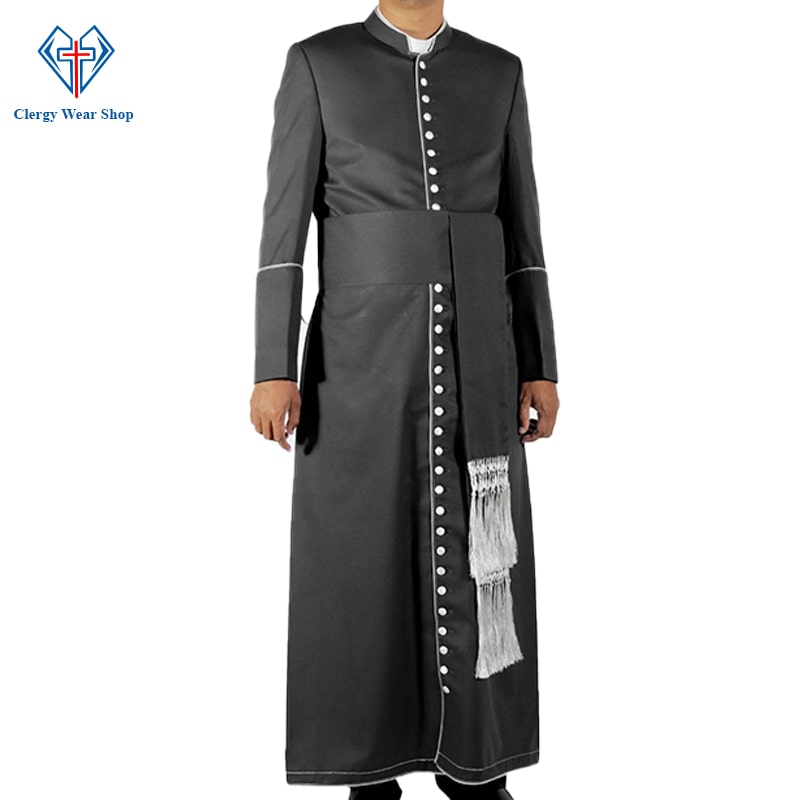Clergy Robes for Men
33 Button Cassock | Robe 33 Buttons
33 Button Cassock: A Traditional Garment with Timeless Elegance
The 33-button cassock holds a significant place in the world of ecclesiastical attire. This traditional garment, also known as a “biretta,” has been worn by clergymen for centuries. Its rich history, meticulous craftsmanship, and symbolic value make it a captivating piece of religious vestment. In this article, we will explore the origins, design, and cultural significance of the 33-button cassock, shedding light on its enduring charm.
The origins of the 33-button cassock can be traced back to medieval times. It was initially worn by Catholic clergy as a practical and dignified garment. The cassock served as a form of identification, distinguishing the wearer as a member of the clergy and reflecting their commitment to the church.
The Symbolism of the 33 Buttons
The 33 buttons adorning the front of the cassock hold great symbolism within the Christian faith. They represent the years of Jesus Christ’s life on Earth and act as a reminder of His sacrifice and teachings. Each button serves as a visual representation of a significant event or teaching associated with the life of Jesus.
The Design and Construction of a Cassock 33 Button
A Cassock 33 Button is meticulously designed and crafted to ensure its exquisite appearance and durability. It features a high collar, long sleeves, and a fitted silhouette. The buttons, typically made of high-quality materials such as brass or pearl, are evenly spaced down the front of the garment. The cassock is tailored to fit the wearer’s body shape, providing both comfort and a dignified presence.
Materials Used in Crafting a Cassock 33 Button
The materials used in crafting a 33-button cassock vary depending on personal preference and tradition. Commonly used fabrics include wool, cotton, and silk. These fabrics are chosen for their durability, comfort, and ability to drape elegantly. The buttons, as mentioned earlier, are often made of brass or pearl, adding a touch of sophistication to the overall design.
Colors and Variations
While the traditional color of a 33-button cassock is black, variations in color are seen in different religious orders or specific ceremonial occasions. Some orders may opt for cassocks in colors such as white, red, or purple to signify specific roles or liturgical seasons. The color variations add depth and visual interest to the garment while maintaining its inherent elegance.
The Importance of the Cassock 33 Button in Religious Ceremonies
The 33-button cassock plays a significant role in religious ceremonies. It is worn during various liturgical events such as processions, ordinations, and solemn Masses. The cassock symbolizes the sacred and reverent nature of these occasions and serves as a visual representation of the clergy’s commitment to their faith and service to the community.
Notable Figures and the Cassock
Throughout history, many notable religious figures have been associated with the 33-button cassock. From influential bishops to esteemed priests, this garment has adorned the clergy who have made significant contributions to their respective communities. The 33-button cassock is a symbol of authority, wisdom, and spiritual leadership.
How to Properly Wear a Cassock
Wearing a cassock requires attention to detail and proper technique. The garment should be tailored to fit the individual’s measurements, ensuring a comfortable yet dignified appearance. The cassock should be worn with a clergy shirt, a waistband, and a coordinating cape or stole, depending on the occasion. It is essential to observe the prescribed liturgical colors and any additional adornments required by the religious order.
Caring for and maintaining a Cassock
To maintain the pristine condition of a cassock, proper care is essential. Regular dry cleaning is recommended to remove any dirt or stains. It is crucial to handle the garment with care, especially when fastening or unfastening the buttons to avoid damage. Storing the cassock in a breathable garment bag or hanging it on a sturdy hanger will help preserve its shape and prevent creasing.
Modern Adaptations and Trends
While the cassock remains rooted in tradition, modern adaptations and trends have emerged over time. Some clergy may opt for cassocks with subtle design elements or personalized embroidery, adding a touch of individuality while maintaining the solemnity of the garment. Additionally, there has been an increased emphasis on sustainability and ethical sourcing of materials, leading to the use of organic fabrics and eco-friendly manufacturing processes in the creation of cassocks.
The Timeless Elegance of the Cassock
The enduring appeal of the cassock lies in its timeless elegance. Across generations, this garment has retained its significance and allure, symbolizing the devotion and commitment of the clergy. Its dignified silhouette, meticulous craftsmanship, and symbolic buttons embody tradition, spirituality, and grace.
Conclusion
The cassock holds a revered place in religious attire, with a history that spans centuries. This traditional garment, adorned with buttons symbolizing the life of Jesus Christ, carries deep spiritual meaning and serves as a visual representation of the clergy’s dedication to their faith. As times change, the cassock continues to captivate with its elegance and adapt to modern trends while preserving its sacred essence.

 Clergy Robes for Men
Clergy Robes for Men Clergy Robes for Women
Clergy Robes for Women Clergy Shirts for Men
Clergy Shirts for Men Clergy Shirts for Women
Clergy Shirts for Women